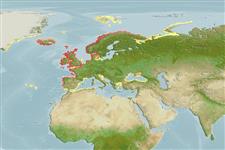Pycnogonida |
Pantopoda |
Nymphonidae
Environment: milieu / climate zone / depth range / distribution range
Ecology
Benthic. Temperate
Northeast Atlantic: Europe.
Length at first maturity / Size / Weight / Age
Maturity: Lm ? range ? - ? cm
Trunk: externally distinct. Cephalothorax: Full complement of appendages; consists of pair of palps, chelifores, ovigerous legs and ambulatory or natatory legs. Female palps and chelifores: smaller than males. Body: elongated and limbs can be used for swimming. Chelifores: Well developed; gather food and carry it to the mouth. Proboscis of the juvenile: Shorter and broader than in adult.
Coastal to slope (Ref. 19); intertidal and sublittoral of rocky shores (Ref. 277). Larvae is an ectoparasite of hydroids. Chemically attracted to various hydroid species (Ref. 121217). Feeding on hosts: hydroid Actinia equina by grasping the sides and rasping away by the action of the jaws; Polyzoan Bowerbankia sp. (Ref. 12); Actinia equina, Dynamena pumila, Bowerbankia sp., and Nucella sp. eggs. Chelifores: responsible for transferring food to proboscis (Ref. 236). Method of feeding: When this species feed on the hydroid Dynamena pumila it slings to the colony by means of its long, slender legs and removes pieces by using the right and left chelifores alternatively (Ref. 236). Free-living (Ref. 3123).
Life cycle and mating behavior
Maturity | Reproduction | Spawning | Eggs | Fecundity | Larvae
The femora are broader when mature eggs are present in them than an early stage of development. The appearance in the previtellogenic oocytes is followed by a rapid increase in the amount of endoplasmic reticulum in the ooplasm and associated with the Golgi complexes which are responsible for the production of the endoplasmic reticulum network which quickly fills the cytoplasm. The eggs develop over winter (Figure 21), egg development starting in young individuals in July. A few eggs have reached the vitellogenic phase by November and the majority do so after March the following year. The yolk precursors enter the egg in low molecular form though later in vitellogenesis a very limited amount of pinocytosis occurs. When males carry eggs they become covered with algae or encrusting polyzoans such as Electrapilosa (Ref. 12).
Roberts, D. 1981 Pycnogonids from Strangford Lough, Northern Ireland. Irish Naturalists' Journal (Belfast) 20(5):189-192. (Ref. 2184)
IUCN Red List Status
(Ref. 130435: Version 2025-1)
CITES status (Ref. 108899)
Not Evaluated
Not Evaluated
Threat to humans
Human uses
| FishSource |
Tools
More information
Population dynamicsGrowth
Max. ages / sizes
Length-weight rel.
Length-length rel.
Length-frequencies
Mass conversion
Abundance
Life cycleReproductionMaturityFecunditySpawningEggsEgg developmentLarvae PhysiologyOxygen consumption
Human RelatedStamps, coins, misc.
Internet sources
Estimates based on models
Preferred temperature
(Ref.
115969): 8 - 13.3, mean 10.5 (based on 405 cells).
Price category
Unknown.
